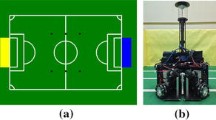Abstract
In order to improve the global self-localization effect of redundant robots, based on the visual tracking algorithm, this paper studies the global positioning method of redundant robots and constructs corresponding models to improve the working efficiency of redundant robots. Moreover, this paper uses the CamShift tracking algorithm combined with the Kamlan predictor to track and predict the dynamic image, and introduces the epipolar constraint in binocular stereo vision to constrain the tracking particles, which improves the matching accuracy of the two tracking particles. The global self-positioning system software is mainly composed of two parts: the robot chassis software and the global self-positioning ontology software. Finally, this paper combines the actual situation to construct a redundant robot global self-positioning system structure based on visual tracking, which can provide a reference for subsequent related research.










Similar content being viewed by others
References
Chen S, Chen Y, Zhang S et al (2019) A novel integrated simulation and testing platform for self-driving cars with hardware in the loop[J]. IEEE Trans Intell Veh 4(3):425–436
Dong Y, Zhang Y, Ai J (2017) Experimental test of unmanned ground vehicle delivering goods using RRT path planning algorithm[J]. Unmanned Syst 5(01):45–57
Gao H, Yu H, Xie G et al (2018) Hardware and software architecture of intelligent vehicles and road verification in typical traffic scenarios[J]. IET Intell Transp Syst 13(6):960–966
Hamarashid HK, Saeed MHR, Saeed S (2017) Designing a smart traffic light algorithm (HMS) based on modified round robin algorithm[J]. Kurd J Appl Res 2(1):27–30
Hamid UZA, Saito Y, Zamzuri H et al (2018) A review on threat assessment, path planning and path tracking strategies for collision avoidance systems of autonomous vehicles[J]. Int J Veh Auton Syst 14(2):134–169
Hang P, Huang S, Chen X et al (2021) Path planning of collision avoidance for unmanned ground vehicles: a nonlinear model predictive control approach[J]. Proc Instit Mech Eng, Part i: J Syst Control Eng 235(2):222–236
Li D, Gao H (2018) A hardware platform framework for an intelligent vehicle based on a driving brain[J]. Engineering 4(4):464–470
Li J, Bao H, Han X et al (2017) Real-time self-driving car navigation and obstacle avoidance using mobile 3D laser scanner and GNSS[J]. Multim Tools Appl 76(21):23017–23039
Liu Y, Cui D (2019) Application of optimal control method to path tracking problem of vehicle[J]. SAE Int J Veh Dyn, Stab, NVH 3:209–219
Liu Y, Cui D (2019b) Path tracking control for inverse vehicle handling dynamics[J]. Int J Veh Saf 11(2):120–135
Lu H, Liu Q, Tian D et al (2019) The cognitive internet of vehicles for autonomous driving[J]. IEEE Netw 33(3):65–73
Matthews VO, Uzairue SI, Noma-Osaghae E et al (2018) Design and simulation of a smart traffic system in a campus community[J]. J Emerg Technol Innov Res (JETIR) 5(7):492–497
Mohamed A, El-Gindy M, Ren J (2018) Advanced control techniques for unmanned ground vehicle: literature survey[J]. Int J Veh Perform 4(1):46–73
Na Z, Pan YH (2020) A research on the classification of intelligence level of unmanned grain harvester[J]. J Korea Converg Soc 11(5):165–173
Ren H, Chen S, Yang L et al (2020) Optimal path planning and speed control integration strategy for UGVs in static and dynamic environments[J]. IEEE Trans Veh Technol 69(10):10619–10629
Sebastian B, Ben-Tzvi P (2019) Physics based path planning for autonomous tracked vehicle in challenging terrain[J]. J Intell Rob Syst 95(2):511–526
Sheng P, Ma J, Wang D et al (2019) Intelligent trajectory planning model for electric vehicle in unknown environment[J]. J Intell Fuzzy Syst 37(1):397–407
Sivanathan A, Gharakheili HH, Loi F et al (2018) Classifying IoT devices in smart environments using network traffic characteristics[J]. IEEE Trans Mob Comput 18(8):1745–1759
Song W, Zou S, Tian Y et al (2018) A CPU-GPU hybrid system of environment perception and 3D terrain reconstruction for unmanned ground vehicle[J]. J Inform Process Syst 14(6):1445–1456
Wang H, Yuan S, Guo M et al (2021) Tactical driving decisions of unmanned ground vehicles in complex highway environments: a deep reinforcement learning approach[J]. Proc Instit Mech Eng, Part d: J Automob Eng 235(4):1113–1127
Wang Y, Goila A, Shetty R et al (2017) Obstacle avoidance strategy and implementation for unmanned ground vehicle using LIDAR[J]. SAE Int J Commercial Veh 10:50–55
Yang T, Jiang Z, Sun R et al (2020) Maritime search and rescue based on group mobile computing for unmanned aerial vehicles and unmanned surface vehicles[J]. IEEE Trans Ind Inf 16(12):7700–7708
Funding
This research did not receive any specific grant from funding agencies in the public.commercial, or not-for-profit sectors.
Author information
Authors and Affiliations
Corresponding author
Ethics declarations
Conflict of interest
The authors declared that they have no conflicts of interest to this work. We declare that we do not have any commercial or associative interest that represents a conflict of interest in connection with the work submitted.
Additional information
Publisher's Note
Springer Nature remains neutral with regard to jurisdictional claims in published maps and institutional affiliations.
Rights and permissions
About this article
Cite this article
Jiao, H., Chen, G. Global self-localization of redundant robots based on visual tracking. Int J Syst Assur Eng Manag 14, 529–537 (2023). https://doi.org/10.1007/s13198-021-01246-0
Received:
Revised:
Accepted:
Published:
Issue Date:
DOI: https://doi.org/10.1007/s13198-021-01246-0




